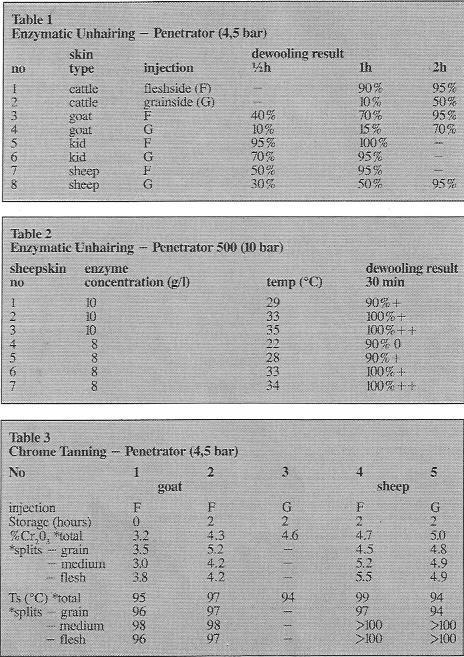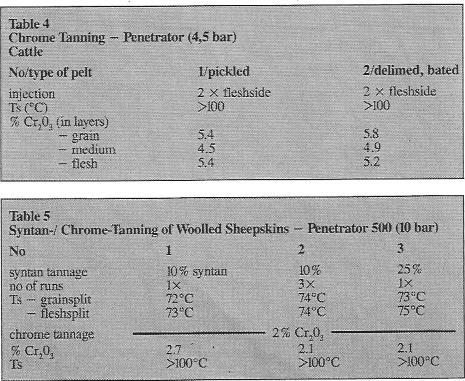Inhaltsverzeichnis
High Pressure Injection for Rapid Processing 1991
At the West German Tanning School, Reutlingen, investigations have been carried out on the use ofthe High Speed Penetrator, especially in the fields of unhairing, tanning and retanning, dyeing and fatliquoring of hides and skins.
The main interest was directed to the following questions:
- Is it possible to perform processes such as unhairing and tanning by the use of the penetrator without any additional mech-anical aetion?
- Does this new technology yield advantages from an ecological viewpoint? Following the chronological order of leather processing the first part of my lecture deals with the unhairing process.
Unhairing:
The unhairing of hides and skins by a conventional liming process using sulphides is an unpleasant procedure for several reasons. On the one hand the use of sulphides is unpleasant to the workers and on the other hand it causes a loading of the effluent by the sulphide itself and the resulting destruction of the hair, so that a waste water treatment is required.
As an alternative, enzymatic unhairing agents, whose aetion is restricted to the hair roots, leaving the hair itself intact, can be considered. Since the effluent loading is reduced and the resulting hair or wool is a useable by-produet, especi-ally in the case of goat or sheep, this method offers significant ecological adyantages.
A widespread use of enzymatic unhairing processes is hindered so far by the comparatively high costs ofthe enzymes and the fact that a more aecurate process control is required as compared to conventional liming. By longer reaction times of about 20 hours, as required in a idrum or a drum painting process, the selectivity of the enzymes may be reduced to some extent so that an attack on the hide protein may result.
This problem can be avoided by using tne injection method for the enzyme application. This results in a drastic reduction of reaction times and of undesirable side-effects. Moreover it seems possible fo use other types of enzymes for a more intensive opening-up of the fibre structure which may, some day, result in one-step enzymatic process for hair Wsenrng, opening-up of the structural network and bating.
However, at present the enzyme unhaired skins need an additional reliming process for opening-up in order to get a pleasing leather quality. In our experiments after the enzyme injection a reaction time of 0.5-3 hours at a temperature of 30 °C was required to achieve a satis-factory hair-loosening.
Some examples of our results are shown in table 1. The reaction conditions of these first experiments were:
- enzyme concentration of 15 g/l (50,000 LVE/g)
- pH 9.6-9.8
- float-temperature 34 ° C
- conveyor speed 0.5 m/min
- pressure 4.5 bar
The data indicates that the injection from the flesh side yields better results than the injection from the grain side in general.
In these experiments hair loosening took 0.5-1 hour in the case of milk-kid skins and sheepskins, whereas in the case of goat skins and a cattle hide which was split after soaking at least 2 hours of reaction time was required. The dewooling of the sheepskin often yielded a con-nected fleece of wool and epidermis.
In more recent trials with the new ' Penetrator 500' and a pressure of 10 bar the following results were achieved (table 2).
Table 1 to 3:
The reaction conditions were:
- enzyme concentration 8-10 g/l
- pH 9.6-9.8
- conveyor speed 0.5 m/min (corre-sponding to about 3 m/min on the techni-cal size machine
- pressure 10 bar
The enzyme concentration was reduced to 8 g/l without any disadvantages, as compared to 10 g/l or the former 15 g/l. The data indicate that the best results were achieved at temperatures of 33-35°C. The double plus and the plus sign indicate an easy or a comparatively easy mechanical de-wooling respectively (dewooling with a scudding knife).
At lower temperatures the enzyme ac-tivity is decreased and temperatures higher than 35 °C may cause problems in the quality of the pelts, as well as in the long-term stability of the enzymes.
There are two more important results of our experiments I have to stress here:
- The use of an appropriate defoamingagent is essential in any case, otherwise the pressure will not reach the needed level.
- The preparation of the hides and skins by a perfect fieshing and a thorough enzyme aided soaking process is the indispensable base for a successful unhairing.
Tanning
The main advantages of using the injection method for chromium tanning are the avoidance of any residual tanning liquors, as arising from the conventional process typically in an amount of 200-400 l/tonne pelt weight with a chromium oxide content of 0.3-7 g/l and the poss-ibility of performing the chromium tannage without any previous pickling,
which results in a simplification of the process, as well as a drastic reduction in the use of sodium Chloride in the tannery.
The high pressure injection ensures the rapid penetration and the uniform distribution of the tanning agents without the restraining effect on the tanning reaction, generated by a pickle.
Table 3 shows some results of tanning experiments with unpickled goat and sheepskins. The experiments were per-formed at 4.5 bar with a 4.5% Cr2O3 -tanning liquor at pH3.2 and a temperature of 20-25 °C.
The conveyor speed was 0.5 m/min for the goatskins and 3 m/min in the case of the sheepskins.
The injection is possible from the flesh side or the grain side. However, in our experiments the injection from the flesh side resulted in more bright and uniformly coloured wet-blues and in somewhat higher shrinkage temperatures. The determination of the chromium oxide content in layers indicates a uniform distribution, which is in most cases better than in a conventional drum process.
A storage of the wet-blues for 2 hours before neutralisation results in a higher chrome oxide content by about 1 %, subsequent neutralisation and fatiiquoring of the wet-blues yielded satisfactory and softleathers.
Using the 4.5 bar penetrator on split cattle hides of about 2mm the results shown in table 4 were achieved. In these experiments two runs at a conveyor speed of 0.5 m/min were required for füll penetration. With the new 10 bar-machine the same results are achieveable with one run at 6 m/min, demonstrating the influence of the pressure.
Experiments on the tanning of woolled sheepskins showed two more advantages
of the new injection method. First of all there is no danger of the wool getting felted and the undesired staining of the wool is reduced essentially by the short float-contact.
Moreover, in the conventional chrome tanning of woolled sheepskin about 60% of the chromium salts remain unused in the residual liquor, due to the consider-able dilution. Here the use of the injection method is exceptionally advantageous. In trials with a 2.3 % chrome oxide tanning liquor a pressure of 4.5 bar and a conveyor-speed of 3 m/min a chrome oxide content of 3.2% couldbe achieved. The shrinkage temperature was in the range of 97.5 to 100°C.
Tanning experiments were also car-ried out successfully with a titanium-aluminium tanning agent (Synektan TAL) and a modified aldehyde (Derugan 2000) respectively, yielding wet white of about 75-83 °C shrinkage temperature.
An interesting alternative in the tanning of woolled sheepskins is a syntan tannage followed by a chromium retannage. In our experiments tanning with a liquor of 10-25% of a phenolic syntan yielded shrinkage temperatures of 72-75 °C, practically independent of the liquor concentration and the number of injection runs. Retanning with a liquor of 2 % chrome oxide resulted in skins with a chrome content of 2.1 -2.7 % which were stable to boiling.
Table 4 to 5:
Wet finishing
Recently we carried out studies on the use of the injection method in the wet iinishing of chrome tanned leathers. Our experiments showed that the application of a fatliquor of 3 % pure fat content on neutralised wet-blue from cattle hides results in an average fat content of about 6-7% on dry leather weight. The fat distribution is similar to the conventional drum process, with a maximum in the grainlay er and a minimum in the medium layer, independent of the side of application.
Investigations in a combined process of neutralising, retanning, dyeing and fatiiquoring established that a full surface dyeing is achieved at best in two separate operations. At first the anionic dyestuff for surface dyeing is applied direcüy on the wet-blue. Subsequently a mixture of neutralising and other syn-tans, polymers, fatliquors and dyestuffs for through dyeing is injected.
If the dyestuff for surface dyeing is applied in one mixture with the other components the surface dyeing never reaches the same intensity as in the first procedure, since the dyestuff has to compete with all the other anionic components for the surface binding sites.
However, this work is just at the beginning and in my opinion a lot of more studies have to be carried out to show the füll range of application of this nevv injection technology.
Kategorien:
Quellenangabe:
Zitierpflicht und Verwendung / kommerzielle Nutzung
Bei der Verwendung von Inhalten aus Lederpedia.de besteht eine Zitierpflicht gemäß Lizenz CC Attribution-Share Alike 4.0 International. Informationen dazu finden Sie hier Zitierpflicht bei Verwendung von Inhalten aus Lederpedia.de. Für die kommerzielle Nutzung von Inhalten aus Lederpedia.de muss zuvor eine schriftliche Zustimmung (Anfrage via Kontaktformular) zwingend erfolgen.
www.Lederpedia.de - Lederpedia - Lederwiki - Lederlexikon
Eine freie Enzyklopädie und Informationsseite über Leder, Ledertechnik, Lederbegriffe, Lederpflege, Lederreinigung, Lederverarbeitung, Lederherstellung und Ledertechnologie


